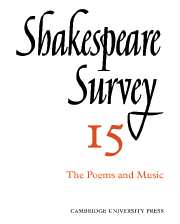Book contents
- Frontmatter
- Twentieth-century Studies in Shakespeare's Songs, Sonnets, and Poems
- Songs, Time, and the Rejection of Falstaff
- Shakespeare’s Sonnets and the Elizabethan Sonneteers
- Love’s Confined Doom
- Beasts and Gods: Greene’s Groats-worth of Witte and the Social Purpose of Venus and Adonis
- From Shakespeare’s Venus to Cleopatra’s Cupids
- Venus and the Second Chance
- Some Observations on The Rape of Lucrece
- An Anatomy of The Phoenix and The Turtle
- Shakespeare and the Ritualists
- Illustrations of Social Life IV: The Plague
- The Soest Portrait of Shakespeare
- International Notes
- Shakespeare Productions in the United Kingdom: 1960
- S. Franco zeffirelli’s Romeo and Juliet
- The Year's Contributions to Shakespearian Study 1 Critical Studies
- 2 Shakespeare’s Life, Times and Stage
- 3 Textual Studies
- Book Received
- Index
- Plate Section
An Anatomy of The Phoenix and The Turtle
Published online by Cambridge University Press: 28 March 2007
- Frontmatter
- Twentieth-century Studies in Shakespeare's Songs, Sonnets, and Poems
- Songs, Time, and the Rejection of Falstaff
- Shakespeare’s Sonnets and the Elizabethan Sonneteers
- Love’s Confined Doom
- Beasts and Gods: Greene’s Groats-worth of Witte and the Social Purpose of Venus and Adonis
- From Shakespeare’s Venus to Cleopatra’s Cupids
- Venus and the Second Chance
- Some Observations on The Rape of Lucrece
- An Anatomy of The Phoenix and The Turtle
- Shakespeare and the Ritualists
- Illustrations of Social Life IV: The Plague
- The Soest Portrait of Shakespeare
- International Notes
- Shakespeare Productions in the United Kingdom: 1960
- S. Franco zeffirelli’s Romeo and Juliet
- The Year's Contributions to Shakespearian Study 1 Critical Studies
- 2 Shakespeare’s Life, Times and Stage
- 3 Textual Studies
- Book Received
- Index
- Plate Section
Summary
‘The Phoenix and the Turtle’ had been nearly smothered in the dust of scholarly debate when a series of brilliant essays succeeded in rescuing it from a sadder fate than its heroes’ eternal rest, ‘enclos’d in cinders’. What radiance might have been lost in the controversy about biography, authenticity and sources the latest critics have fully recaptured. Nevertheless the symbolical birds, to misquote Marvell, still wave in their plumes various light in different eyes. Thus A. Alvarez discovers in Shakespeare’s argument ‘a stringent logic’ while F. T. Prince declares Shakespeare’s use of analytic terminology ‘free and rhapsodic, a kind of ethereal frenzy’, in a poem which ‘consists in a marriage between intense emotion, and almost unintelligible fantasy’. To the same editor, nothing could be ‘further from the methods of Donne’s love-poetry than the method of this poem’. Yet ‘ The Phoenix and the Turtle ’ is included in Helen Gardner’s anthology, The Metaphysical Poets, and Henri Fluchère would rank the poem in ‘the highest tradition of “metaphysical” poetry’. Now, these assertions, slightly qualified, may not prove actually inconsistent. But the obvious clash between such statements—and many more instances could be found—invites a resurvey. However loath one may feel to burden this lyrical flight with further plodding research, a re-examination of the bird symbolism and the ‘Platonic’ assumptions, supported by a fresh array of parallels, is required to avoid laying undue emphasis either on the poet’s dependence on tradition or on his self-conscious originality in the handling of the Phoenix theme.
- Type
- Chapter
- Information
- Shakespeare Survey , pp. 99 - 110Publisher: Cambridge University PressPrint publication year: 1962



